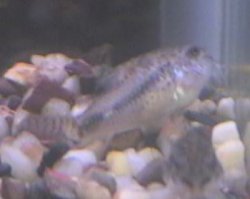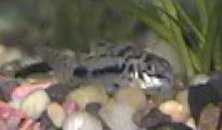 |
 |
|
|
Last Updated: 2/19/14


Quick Information
Description and Varieties
Setup and Water Preferences
Sexing
Breeding
My Cory Habrosus
Links and Pictures
For information on my past cory habrosus' tank, visit my tank page.
Note: I do not have much experience keeping cory habrosus so that this page does not contain much information. If you have experience with these fish or a web site about them, please let me know.

Common names: Cory habrosus, pygmy cory
Scientific/Latin names: Corydoras habrosus
Maximum length: 0.75 inches
Colors: Gray, black, white
Temperature preference: 73 to 79 degrees F, can withstand 68 to 85 degrees
F
pH preference:7
Hardness preference: Soft to medium-hard
Salinity preference: 1 Tablespoon per 20-40 gallons
Compatibility: Good; other fish may harm them due to their small size
Life span: Unknown, a few years
Ease of keeping: Moderate
Ease of breeding: Moderate

There are three common species of tiny corydoras. They are Corydoras habrosus, Corydoras hastatus, and Corydoras pygmaeus. All three are similar in size (3.5, 3, and 2.5 cm maximums respectively) and requirements. Their patterns are different. Corydoras habrosus have more black spots and striping down their bodies than the other two fish. Corydoras pygmaeus was once thought to be a subspecies of Corydoras hastatus. Both of these fish have a dominant black stripe down their bodies and a black spot at the beginning of their caudal fins. Corydoras habrosus has splotches of black. Most of the information on this page is equally applicable to all three species. All three species are small and all called pygmy cories. Due to their size, they may be eaten by tank mates.
Unlike most cories which are larger, these three pygmy cories are all active swimmers that spend time swimming throughout the tank instead of mostly on the bottom. Such active swimming in other cories would indicate either that the cories were either sick, under severe stress, or spawning.

I have not found any information specific to cory habrosus but they should be similar to most cories. They will do well between 72 and 82 degrees F in water that is soft to moderate. A pH of 7 seems to be fine. Due to their small size, care should be taken to be sure the fish do not get sucked into any filters or harmed by larger fish. They do best with other tiny fish. Like most cories, cory habrosus prefer to be in groups of at least four. While most catfish are sensitive to medications (especially parasite-killing "medicines"), cory habrosus are even more sensitive. Avoid medicating their tanks if at all possible. I once treated a tank with a half dose of parasite killer and only these fish died.
These small cories will eat most small foods including flakes, freeze-dried, frozen, and live foods. Tetra's Tabimin food works well. I break off just about 1/4 of one pill once a day and put it in the tank where it sinks and my four cory habrosus eat it. They also eat any flakes that fall down to the bottom.
Pygmy cories like dense vegetation but also some swimming room. Like most catfish, they will gulp air.

Females are fatter and larger as with most cories. My females are twice as big as the males and super fat.
For Corydoras pygmaeus, the male is said to be slimmer, have a more pointed dorsal fin, and a darker black stripe down his body than the female.

I have not found any information on breeding cory habrosus except that they are easy to breed and breed like most cories. See my panda cory page for information on how panda cories breed since cory habrosus are most likely very similar.
Some information that I found on breeding Corydoras pygmaeus follows and may apply to cory habrosus as well. Put several males per female in a tank with lots of plants. The temperature should be 75 to 78 degrees F although they will breed from 60 to 75 degrees F but not as successfully. The water should be clean and clear (as with all fish really). The male quivers in front of the ready female for a few seconds. Then, they get together near the bottom for a few seconds, and he gives his sperm to her. She then puts a single egg in her pectoral fins and carries it around the tank to find a place to stick it on plants and glass. Each egg takes about one minute. She may lay 40 to 60 eggs over up to three hours. Only about a third are usually properly fertilized. The eggs hatch in 4 to 6 days at 75 to 78 degrees F. It takes 2 to 3 days for the yolk sack to be absorbed before the fry eat micro foods. By two weeks of age, they can eat newborn brine shrimp. In about a month, they are fully formed. It takes 6 to 7 months for them to sexually mature.
I have witnessed my female cories zipping about in the tank while extremely large. I presume they wanted to breed. The males did not seem very interested. I never found any eggs or fry from my fish while they were alive.
Also, visit my breeding and fry care page for more information on how to care for the fry (tank setup, feeding, cleaning, etc.).

I had Cory habrosus in my 20 gallon tank but they all have died. See my aquarium tanks page for more information. They were very active and ate mostly Tabimin. I started with four of them in a 3 gallon Eclipse tank on 1/29/00. By 10/11/00, they were doing well, and it looked like I had two females and two males. Two (females) were extremely large and fat. They had grown larger than I thought cory habrosus grew (they were pushing the 0.75 inch mark). One was medium in size. I assumed this was a healthy male. The final cory was a very tiny (1/4 the size of the females) fish. I assumed this was an unhealthy male. He also was missing his barbels. He died on 11/4/00. On 6/23/01, I moved the three cories (2 female, 1 male) into my 20 gallon tank (because I had moved those fish into my 50 gallon tank after the goldfish in there died so it was musical aquariums) where I thought they would get some exercise and spawn. The fat females showed excited spawning behavior but the male could not have cared less! See the top of this page for a photo of one of my female Corydoras habrosus.
On 9/16/01, I rescued a lone adult female Corydoras habrosus from the local aquarium store and added her in with the other three cories in my 20 gallon. The established fish found the new female interesting, and she was darting a lot at first but seemed to have settled in. If only the male had shown interest, the three females would probably have spawned with him. Unfortunately, after a period of spinning and rapid breathing for a few weeks, the new female died on 11/3/01. The remaining three seemed fine. Then, on 11/20/01, after a week of spinning and appearing dead, another female cory died leaving only a pair of them left. Whatever protozoan or critter they had killed them. The other fish in the tank seemed fine until a glowlight tetra stopped moving on 11/24/01. Also, on 11/24/01, the male Corydoras harbrosus died so that only one female was left. So, they definitely would not be breeding. The remaining female soon began behaving erratically as well and her barbels rotted off (common in ill cories). I treated the tank with a parasite killer that said it worked for protozoans. A few weeks later, on 1/03/02, I found the last Corydoras habrosus dead. I had had her for a year and a half.
I had four Corydoras habrosus in my 20 gallon planted tank for about two weeks in late 1996 before they all died. They most likely died from a mild outbreak of some protozoan which also has claimed otocinclus and fry in my tanks. At the time, I used a mild treatment of salt (very low concentration) and half dosages of a parasitic medication that I have used before with no fatalities. Obviously, these tiny cories are extra sensitive since they died. Avoid medications with catfish.

I have not found any links or pictures on cory habrosus except the two below. Let me know of any. I have two photos at the top of the page.
Corycats - a site with many photos of corydoras catfish including C. habrosus.
Corydoras Encyclopedia - includes some photos of C. habrosus.
I Love Corydoras! - site includes photos of C. habrosus and lots of other cory stuff.
Corydoras World - a large cory site.
Scotcat.com - a site dedicated to catfish.
Planet Catfish - a UK catfish page with information on lots of catfish.
|
|
Pet Link Banner Exchange: |

|
|
|
There have been 51,181,002 file views (file views since 2006, page views before that) to Fishpondinfo from December 1, 2003 through August 17, 2019 (stats lost after that). |
|

|

|
E-mail RobynCopyright © 1997-2025 Robyn Rhudy |

|
 |